Lee Moller's Blog, page 7
September 12, 2020
Hitler's Savage Canary; David Lampe; 1957; Frontline Books; 228 pgs
 My heritage is Danish and so I feel a certain obligation to understand the role of Denmark in the war. There are four Scandinavian countries: Iceland (allied possession during the war); Norway (occupied and resisted); Denmark (occupied and resisted); and Sweden (neutral but anti-German). Finland is not Scandinavian.
My heritage is Danish and so I feel a certain obligation to understand the role of Denmark in the war. There are four Scandinavian countries: Iceland (allied possession during the war); Norway (occupied and resisted); Denmark (occupied and resisted); and Sweden (neutral but anti-German). Finland is not Scandinavian.Denmark, a small country of only 4 million, was overrun within 24 hours in April, 1940. Denmark borders Germany and Danes and Germans share a lot of common culture. The Germans recognized the importance of Denmark for its food supply and its strategic location. As such, the Germans "went light" on the Danes.
Many brave stories came out of the Danes struggle to harass and damage the German war effort. The most significant strategic contribution of Denmark took place immediately after D-Day when the resistance bombed rail lines and such and prevented the Germans from rushing reinforcements to the new front.
They also found the wreckage of one of the early V1s on Bornholm Island. The intel from that discovery led to the bombing of Peenemude, the Nazi V-weapons development site.
A famous mission of the war was the twin raids on the Gestapo Headquarters in Copenhagen and Arhus. Shell House in Copenhagen was bombed my Mosquitos at very low flight levels. The Germans had created a prison for resistance fighters on the roof of Shell House and the Mosquitos literally had to skip their bombs in through the front doors of the building. Germans died, Danes survived.
For those involved, including my father, the most famous Danish accomplishment was to get almost the entire Jewish population of Denmark out and over to Sweden just one day before they were due to be rounded up and exported to the German camps.
Like any other occupied country, the Danish underground conducted sabotage raids and paid the price, usually in the form of torture and death. Many civilians were shot in retribution. The underground also killed many Danish collaborators (it was called liquidation).
Many amusing-in-hindsight stories also came out. The one I like best is the British radio kits that were sent to Denmark during the war. They ran on AC. Denmark at the time was DC. The Danes, took the British version apart and made a new one. It was 1/3 the size, ran on AC or DC, and was more rugged and much easier to manufacture. Eventually, the British adopted the Danish design.
Also amusing, the Germans set up guard posts are key intersections in the city. They were protected by 4 foot tall concrete walls . The wall left only the German's head and shoulders exposed. The Danes, as they walked by, would hang signs on the wall saying "This Nazi is not wearing any pants."
One attack was called the Smorrebrod Raid. Danish airport workers smuggled plastic explosives into their airport and placed time-delayed bombs all over the place. They smuggled them in in what we would call their lunch boxes (Smorrebrod means "Butter and Bread") which the German's did not search. After such a raid, the "perps" would generally be smuggled out of Denmark to Sweden.
It should be said that the Norwegians fought and brave fight against the Germans and suffered terribly. Sweden, while technically neutral, provided aid to its neighbors at every opportunity, risking the wrath of the Nazi's.
Published on September 12, 2020 09:51
The Invention that Changed the World; Robert Buderi; 1996; Touchstone Books; 478 pgs
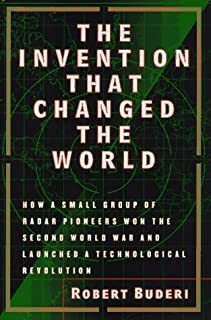 In 1880, William Herschel tripped over an astounding discovery. He asked a simple question. Sunlight warmed the skin. Do the different colors of the rainbow carry different amounts of heat? He set up a prism to cast a large rainbow on a wall (this is tricky because the angles must be right and the pesky Earth just keeps on rotating). He placed a thermometer in several different bands of color, and a control thermometer just off from the red end of the spectrum where no light fell at all. To his amazement, the control thermometer recorded a rising temperature and the others nothing. He had discovered infrared light and that the rainbow is not just what meets the eye. This opened the door to the entire electromagnetic radiation (EMR) spectrum. By WWII, they had a full theory of light from Maxwell, and radio was all the rage.
In 1880, William Herschel tripped over an astounding discovery. He asked a simple question. Sunlight warmed the skin. Do the different colors of the rainbow carry different amounts of heat? He set up a prism to cast a large rainbow on a wall (this is tricky because the angles must be right and the pesky Earth just keeps on rotating). He placed a thermometer in several different bands of color, and a control thermometer just off from the red end of the spectrum where no light fell at all. To his amazement, the control thermometer recorded a rising temperature and the others nothing. He had discovered infrared light and that the rainbow is not just what meets the eye. This opened the door to the entire electromagnetic radiation (EMR) spectrum. By WWII, they had a full theory of light from Maxwell, and radio was all the rage.The book begins in the 1930's. Radio was not the concern, impending war was, and the first crude radar units were built. Radar is the invention of the title. Radar saved Briton. It is said that the A-Bomb ended the war, but radar won it.
As dry as this book might sound, it is quite engrossing. I must admit I went rapidly through the last 120 pages or so that covered the cold war and other events leading up to our modern world because I am already reasonably familiar with them (it is mostly computer related). My interest in this subject dovetails nicely with my interests in technology, WWII, and the history of science. Science and war go back a long way, and there is nothing like a good war to accelerate both basic science and technology.
A primer is perhaps useful. Light is an ambiguous term. We use it to mean the light that we can see, and any form of light whether it can be seen or not.
The broad forms of light are: Radio; Cell Phone; Microwave; Infrared; Visible; Ultraviolet; X-Rays; and Gamma rays. In wave lengths, these go from miles in the radio spectrum to femtometers and shorter (smaller than the nucleus of an atom). Frequencies are the inverse of wavelength and energy is proportional to frequency. So radio waves are very low frequency, low energy, very long wave length light. Gamma rays are very high frequency, high energy, short wave length light. Radar focused primarily in the microwave band, around the same frequencies used by your microwave oven, with a wavelength of around 2 centimeters. Sort of in the middle.
Generally speaking, the higher the frequency, the lower the wavelength; and the better you can see. To use radar to see an enemy airplane, centimeter wavelengths were the key. One problem is that different materials interact with EMR in different ways at different frequencies. For example, rain plays havoc with 1 cm radars because water absorbs the energy (which is why your microwave works).
In 1940, a group of Brits went to the US to trade secrets. This was known as the Tizzard mission. The US needed the British technology, although they did not know it at the time, and the Brits needed the US's manufacturing capabilities. The Brits brought their super-secret Resonant Cavity Magnetron. This device could create strong emissions of microwave energy at just the right wave lengths. Radar won the war, the magnetron made radar work. The Americans were gob-smacked. The RadLab was created and it produced radars at a dramatically increased pace. Radar was used to detect incoming threats, count them, and get there altitude (all different applications), aim guns, monitor traffic in harbors, guide plans to a safe landing (today we call this ILS for Instrument Landing System), FoF (Friend or Foe) systems and lots more.
Aside: Some FoFs worked by detecting small changes in a planes returns caused by distinctive engine vibrations. Amazingly, analog computers of the day could sniff this out. Cool.
More than a few famous names worked at the RadLab, including Nobel winner I. I. Rabi, Robert Watson Watt (he is related), William Shockley and ploy-math Luis Alvarez. Alvarez would move on to the Manhattan Project, and later in his career he would be known for the asteroid/dinosaur extinction theory.
The development of the bomb took most of the Nobel winners out of the market. This lead to the following amusing conversation:
S1: The bomb guys get all the breaks! They snatch up all the Nobel winners first.
S2: Well, Rabi just won, so we have one too now.
S1: Yeah, but we have only had ours for 3 weeks!
If soon became apparent to the higher-ups, especially Vannevar Bush, that basic science was important, And so scientists suddenly found themselves considerably higher up in the food chain, leading to this: A scientist found himself being frustrated by a military pencil pusher. He (sorry, they are all he's) turned to his tormentor and asked "Who do I see about getting you fired?"
Meanwhile, the Germans were working on their radars in a kind of intellectual, evolutionary game of leapfrog. One project was code named Freya. Freya, Odin's wife in Norse mythology, and the source of Friday (Freya's Day), had a magic necklace that allowed her to see for hundreds of miles in every direction. Only the Nazis would be arrogant enough to use her name on a radar project.
This book is long and full of a lot of detail. It has a good index, lots of notes, and a list of acronyms used. Very helpful. Radar systems were the start of high frequency electronics. Modern computers were a direct result of all that. Radar technology combined with computing power opened up the rest of the EM universe to us. The computer power came from the transistor, invented by Shockley. Early analog computers would contain hundreds of tubes, each tube being a bit. Today, millions of transistors can fit on the head of a pin.
The largest radio telescope in the southern hemisphere is located in Parks Australia in the middle of a sheep paddock. It was built by RadLab alums after the war.
If you enjoy reading about WWII, EMR technology, applied physics and its impact on our lives, this is a book I would recommend. Another, longer, similar book does the same for nuclear physics: The Making of The Atomic Bomb.
It has been suggested that radar advanced applied solid state physics by two decades. The PC, cell phones, the internet, HD TV, smart phones, astronomy, planetary research, NMR machines… a near endless list of things we have already started to take for granted. All delayed by twenty years. You would recognize this world because in people terms, it is practically yesterday.
A recent puff (read: stupid) question for politicians is "If you could, would you go back and kill Hitler as a youth?" Well, if you did, you would have to give up quite a lot today.
Published on September 12, 2020 09:41
Heretic; Ayaan Hirsi Ali; 2015; Harper; 239 pgs, notes
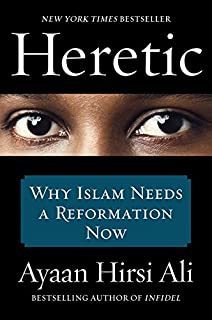 I continue my research into religion. News flash: it is still stupid! If you want to find out more about Islam, this book is a good place to start.
I continue my research into religion. News flash: it is still stupid! If you want to find out more about Islam, this book is a good place to start.In my youth, I read a lot of science fiction. Many plots would feature a radical religious sect not unlike Islam as the main "bad guy". I have always been conscious of religion trying to tell me what to do. Now I see this SF plot unfolding on a global scale. What really bugs me is the hypocrisy of the piously religious who brush off the terrors of Islam with moral relativism.
You have probably seen Ali on TV. She is hard to miss. She was born a typical rabid kill-the-infidel Muslim. She escaped an arranged marriage and made it to the Netherlands. There she as elected to the Dutch parliament. Now she is an atheist, a lecturer at Harvard, and advocate for Islam reform. I say she is hard to miss because she is thin, pretty and about 6 feet tall. She has written the other books which I have note read: Infidel; Nomad; and The Caged Virgin.
If you thought Islam was barbaric, rest assured you are correct. Where she grew up, every Friday was marred by stonings, beheadings and limb removal by sword. At that is the tip of the iceberg,
She is an excellent writer, despite English not being her native tongue.
Basically, she argues that Islam is still a barbaric religion. Christianity was born inside the Roman Empire. They had to go along to get along. Their book was written by men, and therefore subject to debate, but it is still holy. Christianity and politics do not mix. Islam also has two other thorny problems. Unlike Christianity, it lacks any kind of hierarchy. That is, the is no pope to sanction or condemn an imam. The second is that the Koran is literally the last word of god. Mohammed wrote the Koran as a direct instrument of god. The Bible was written by men. The Koran, as the literal last word from god, is absolute, The Bible is haggled over all the time. Believers in the literal last word of god are, for obvious reasons, hard to reason with. Once a Muslim accepts this one point, everything else follows from it and that Muslim becomes the equivalent of a blood thirsty fundamentalist Christian. For these people, their goal is simply to take over the world.
In a sense, you can argue that Islam is religion as it would have itself: An absolute belief system with answers for everything, that is enmeshed in politics, has laws for everything, and any deviance is crushed, usually to death. In their world, you can die for asking a single innocent question, such as "Why pray five times and day, and not four?"
In the US, an irrational battle of labels is waging. Remember Ben Affleck blowing a gasket when someone even mentioned Radical Islam, shouting "racist" and "Islamaphobe"? Obama wont utter the phrase. And yet it is accurate and neutral in tone.
Ali argues that moderate Muslims (she calls them Mecca Muslims) must take a stand, reform Islam, ban jihad, and bend to "western" values. Period.
Moral relativism be damned, this is an evil religion. If someone who shouts "Allahu Akbar" while killing an innocent, that person is a Muslim, regardless of protestations to the contrary. And it is other Muslims who must recognize this and stop them. Actions speak loudly, and in this case, we must define our groups by their actions. We cannot tell what they think.
Ali goes over her history quickly as it is covered in her other books. She is risking her life and is a remarkable woman. My list admirable women includes Vashti McCollum, Elizabeth Warren, and others, and now Ali.
Published on September 12, 2020 09:31
September 11, 2020
The End of Faith; Sam Harris; 2004; WW Norton; 235 pgs + notes, index
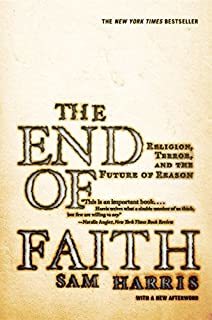 Sam Harris is one of four outspoken atheists of our time. The others are Dawkins, Dennett, and Hitchens. He is a philosopher by training. He is smart fellow and the book lays out a tight argument for a societal rejection of religion. The sins of religion are plain to see. Religion and its corollary god, are simply ideas, poorly thought out ideas, that have been elevated to sacredness.
Sam Harris is one of four outspoken atheists of our time. The others are Dawkins, Dennett, and Hitchens. He is a philosopher by training. He is smart fellow and the book lays out a tight argument for a societal rejection of religion. The sins of religion are plain to see. Religion and its corollary god, are simply ideas, poorly thought out ideas, that have been elevated to sacredness.God has written a lot of books, or so the priests tell us. Why then, as Harris points out, is he such a crappy writer compared to people like Shakespeare, whom he created?
The idiocies of religion are laid out in full, blood-red color. A few years ago, there was a fire in a building in Mecca. First responders refused to aid burning women inside the building because they were not properly dressed. The Bush White House was a rats nest of prayer groups and Christian circles as the US invaded Iraq to get their president another term.
When asked, most believers will tell you there is nothing you could say, do, or show them that would change their minds. Harris points out that this is an admission that, whatever their beliefs, they do not represent a model of the real world. It is easy to show that what comes next is rarely pleasant.
One point he makes, which should get a lot more attention, is the idea of true faith. If people, especially radical Islamists, really believe that the Koran is the last word of Allah, and that all the world should bow before him, them we are in grave danger. Any belief gripped that hard is a danger to society.
Fun fact 1: The RCC never excommunicated a single Nazi, but kept Galileo in jail for 300 years.
Fun Fact 2: The Nazis did not invent the yellow star of David as a Jewish ID badge. Islam in Baghdad did.
Fun Fact 3: Spain translates more books into Spanish in one year than Islam has translated to Arabic in 1,200 years.
Faith is the enemy. The large majority of believers in even the lesser Islamic countries agree that suicide bombing is a good thing, and that the bomber goes straight to heaven.
Harris points out that religion is in our society too. Stem cell research was banned by Bush for religious reasons. Prohibition and the enormously expensive war on drugs, like all victimless crimes, are a product of religion. Moral relativism is a scourge. Evil is evil and we need to come to grips with that.
The last chapter, which has been criticized by others, focuses on spirituality and meditation. Frankly, my brain seizes up when words are bandied about with respect to our internal conversations with ourselves. Harris is fairly well know for his thoughts in this area. The good news: he will not try to kill you if you disagree.
Faith -- true faith -- is the enemy.
Published on September 11, 2020 22:34
Sapiens; Yuval Noah Harari; 2014; McClelland and Stewart; 416 pgs
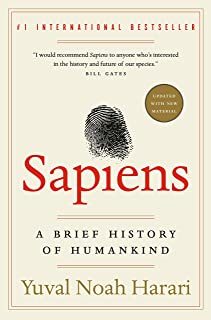 "The wandering bands of Sapiens storytellers were the most important and destructive force the animal kingdom ever produced."
"The wandering bands of Sapiens storytellers were the most important and destructive force the animal kingdom ever produced."This phrase appears early in book. It is another book about the rise of human kind on this Earth. It is similar to Guns, Germs and Steel and A Brief History of Everything.
I read it mostly for the early history: the invention of languages, stories, religions, gods and kings and such. In that respect it delivered.
One myth the book explodes is the idea of primitive cultures as being more in touch with and more cooperative with nature. It is not true. Every human group, everywhere, wasted no time in bending the environment to its one uses, and grabbing all the low hanging fruit as fast as they could, lest the other guy get it. Think the death of the North American mega fauna and the hands of the native populations.
It takes on what the author calls "romantic consumerism"… the general idea that you life is best served by jetting all over the world and getting exposed to as many cultures as possible. It also attacks cultural relativism for the evil that it is.
The author made an interesting observation about religions in general. They can be broken down into three gross categories: Many gods (polytheism); Two gods (dualism); And one god (monotheism).
Polytheism is marked by a laid back attitude. If you meet someone who believes in another god, no problem. You just add it to the list.
Dualism is marked by conflict: Creator versus destroyer; good versus evil; heaven versus hell.
Monotheism (i.e.: the big three) is awash in the blood of the non-believers.
Roman Catholicism is kind of an odd-man-out. They believe in one god with three faces (father son and holy ghost). They embrace dualism with God versus Satan. And they are also polytheistic in that they have hundreds of saints, and each saint has its followers. Practically speaking, "saint" is just another word for demigod.
The author uses the phrase "the exception that proves the rule" incorrectly and more than once. Truth be told, few people know how cliché is intended to work.
It has some interesting observations about money and credit. The author argues that the British obtained global imperialist domination over France because they paid their bills and were a good credit risk. Credit at the time was a new concept that the French failed to appreciate.
The last few chapters get into philosophy, happiness, and extrapolating the modern world out into the future, a most dangerous game.
An easy read, with the occasional bit of humor.
Published on September 11, 2020 22:22
Life Sentence; Christie Blatchford; 2016; Double Day; 351 pgs, index
 Another very enjoyable book from Christie Blatchford. I have always liked reading her columns in the NP. Her earthy style of writing is restrained in newsprint, but not so in her books. It is a worthy successor to Helpless, the story of the OPP and the feds turning their backs on the small town of Caledonia, ON. Truth be told, the sins of the system as described in Life Sentence do not hold a candle to the system allowing politics and ambition to trump even the most basic tenets of the rule of law in Caledonia.
Another very enjoyable book from Christie Blatchford. I have always liked reading her columns in the NP. Her earthy style of writing is restrained in newsprint, but not so in her books. It is a worthy successor to Helpless, the story of the OPP and the feds turning their backs on the small town of Caledonia, ON. Truth be told, the sins of the system as described in Life Sentence do not hold a candle to the system allowing politics and ambition to trump even the most basic tenets of the rule of law in Caledonia.A nice type size and good leading means a fairly quick read.
The book is broken into broken into several large chunks consisting of an anecdotal review of her career; then four long chapters on the big cases: R v. : Abreha, Elliott, Bernardo; and Ghomeshi.
In the opening chapter, she recounts some fun moments, like when the Special Investigative Unit that investigates police shootings hired a hot homicide detective only to discover that he was a fraud; or the when the government hired a race relations specialist who told lawyers that the Holocaust was not racist because no black people were involved. She notes as well, after years of legal wrangling, Duffy is back in the Senate sucking on the same teat as before. And more importantly, she asks why judges do not get the same scrutiny as senators. She points out that judges work for us, and that it is within our rights to criticize them, and they have a duty to disclose expenses just like everybody else.
In Abreha, Christie rails against the condescending treatment of jurors. In fact, we just had the Oland case pitched due to an issue of jury instruction. Jurors seem to be unable to get even the most trivial of research sources themselves, like having access to a dictionary. It is assumed that jurors are incapable of, for example, separating past misdeeds from current misdeeds, but it is inherently assumed that lawyers and judges are capable of such feats, as well as many others that mere mortals can only aspire to. Blatchford quotes one juror who said: "The arrogance of the judicial system doling out just enough information to keep us pure 'intolerable'. " I agree. In some cases, judges have actually lied to jurors. Actually, they all lie to the jurors, because they all say the same thing at the end of the trial… "You have now heard all the evidence.", and that is almost always a lie. If you say that is not right, you will get a lecture on "probative value versus prejudicial effect". IMHO: If we are going to have juries, they should have all the facts.
The Elliott case focused on a judge Cosgrove who went right off the rails during the trial. To make a long weird tale short, Cosgrove was incompetent. He threw his weight around illegally, and, at the end of the day, still did not acknowledge his misdeeds. Cosgrove was a patronage appointment. The Canadian Judicial Council was involved and actually debated whether "incompetence" should be tolerated in judges, so untouchable as they are once appointed. Camp is another judge recently in the news who actually used "ignorance of the law" as an excuse for his errors as a judge!. The appointment process is totally screwed up in Canada, but the good news is that it is getting better.
Reading about Bernardo again is hard. The facts of the case are stomach-turning. The Bernardo trial was totally screwed up by the prosecution. Innocent lawyers were trashed by the system. Politics, optics and expediency ruled the court's decision making processes. The crown made a deal with the devil (Homolka) when they definitely should not have. But worse for the legal system, victims were granted de facto status in the court, with their own attorney, who the crown then tasked to do things that were clearly in conflict. This mess resulted in some really dumb stuff. The press was not allowed to see the Homolka tapes (due to the victim's weight in the court), but could hear them. But the sound was bad, so the crown provided a transcript that they could not read, but the cops could read it to them. So the reporters had to scribble the text from the readings of the cops while listening to a tape, which they could not understand, of a video they were not allowed to see. The Bernardo case saw the legal system turn on itself, and it was ugly. This rise of the victim does not bode well, and we are seeing the impacts today. The victim should have no say in the evidence presented at trial, but in Bernardo, they ruled the roost. The state even went after reporters for breaching court orders WRT banned information, information that they had made public earlier. In one instance, the OPP fabricated evidence to get at a lawyer who had crossed the Province's AG, who was hip deep in conflict issues.
Finally, the Ghomeshi trial is discussed, and it too was a fiasco. Once again, the victims rose up, screwed up everything, and disappeared. The details of the Ghomeshi trial are still fresh in most peoples mind, but if you want more, read the book.
This was a good read. The system is not broken. I am sure 95% of convictions are routine and well handled. But it seems the bigger the trial, the more it seems like the lunatics are running the asylum. We recently had a literal show trial and it showed us that the judge was a screw-up.
Published on September 11, 2020 22:12
T. Rex and the Crater of Doom; Walter Alvarez; 1997
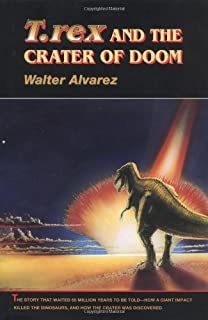 This book is better than its sequel, A Most Improbable Journey. It deals with larger issues and documents one of the great over-arching discoveries of the 20th century, namely that the Earth was hit by a 10 km wide rock in the Yucatan that wiped out the dinosaurs as well as many other kinds of creatures, such as the ammonites (nautilus like critters that ruled the oceans for millions of years). This all took place October 29, 65,000,0000 years ago, at 9 AM in the mourning.
This book is better than its sequel, A Most Improbable Journey. It deals with larger issues and documents one of the great over-arching discoveries of the 20th century, namely that the Earth was hit by a 10 km wide rock in the Yucatan that wiped out the dinosaurs as well as many other kinds of creatures, such as the ammonites (nautilus like critters that ruled the oceans for millions of years). This all took place October 29, 65,000,0000 years ago, at 9 AM in the mourning. The impact was stupendous. The rock was so big, it's leading edge was grinding a huge hole (the Chicxulub Crater) in the Earth while the trailing edge was still in the upper atmosphere. A second later, it was all over but for the fallout, burning atmosphere, huge tsunamis, and a stifling hot (due to released CO2) "winter", and dust that blacked out the sky.
The simultaneous exploding of every nuclear weapon on Earth would be like a fart in the wind by comparison.
The story of the discovery surrounds the KT boundary, a thin layer of clay that marks the end of the Cretaceous (and the dinosaurs) and the start of the Tertiary (the first layer of which is the Danian, after the Danish site where it was first described).
The idea was floated that a impact may have killed the dinosaurs. Walter's famous physicist Dad, Luis, suggested looking for a radioactive isotope of an element that is found in meteors, but generally not on the Earth's surface, in the KT boundary. Iridium was the final choice. The other "tell" is something called "shocked quartz, which I will leave to reader to find out about.
Skip to the end: Iridium was found all over the word in the KT (K is used because C was taken, and it also came from the German for chalk).
This is where the story is different from other scientific detective stories. I cannot recall a discovery that had so many scientists excited from so many disciplines. Geology, of course, but paleontology, archeology, planetary astronomy, astrophysics, nuclear physics, chemistry, biology, the physics of impacts, and so on. Soon, evidence was popping up in multiple fields at once, and an idea that was poo-poo-ed became accepted fact in a just a few short years. Sadly Luis died before his idea bore fruit.
This is a very approachable book, and a quick must-read for any student of the processes of science (aka human knowledge). Since then ( around 1990), 130 more ancient craters have been found.
Published on September 11, 2020 14:13
Rise and Fall of the Dinosaurs; Steve Brusatte; 2018; Harper Collins; 349 pgs; index, notes
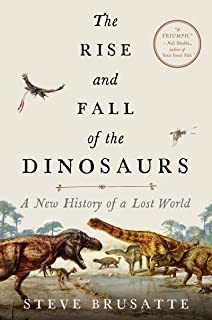 If we ignore DJ Trump, we live in the best of times. I am fascinated by the world of dinosaurs and their kin. We have been masters of the Earth for a few thousand years. The dinosaurs were on top for 150 million years. They are still with us today as birds… a little less dangerous than T. Rex.
If we ignore DJ Trump, we live in the best of times. I am fascinated by the world of dinosaurs and their kin. We have been masters of the Earth for a few thousand years. The dinosaurs were on top for 150 million years. They are still with us today as birds… a little less dangerous than T. Rex.Steve Brusatte is a young enthusiastic paleontologist. He is probably the best writer on the subject I have read. His book is not a who-dun-it like books on the fate of the dinosaurs, but rather an epic tale of natures forces and dumb luck clashing together. It ends, of course, with the Yucatan impact of a 6 mile across asteroid or comet 65 million years ago.
We are in the best of times because we have learned more about dinosaurs since I was born than we ever knew before. One hundred years ago, if you found a rock that might contain a fossil, you could spend months trying to free it from its matrix of rock only to find a common bone. Today, scientists can run it through a CT scan and find out in minutes. Ground penetrating radar can let researchers look underground without having to dig. And, of course, computer modeling has vastly improved our understanding of how these animals lived and died.
There is no appreciable jargon used. It is just a fine, engrossing read that gives good picture of our current understanding of the subject and a look at the people who will dominate it for the next few decades,
Published on September 11, 2020 13:05
September 9, 2020
Voodoo Science; Robert Park; 2000; Oxford University Press; 213 pgs, index
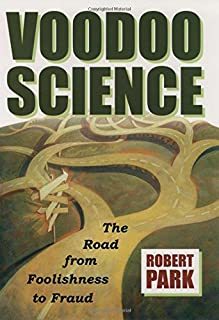 Text of article
Text of articletext
text
Published on September 09, 2020 12:48
August 28, 2020
Evolution vs. Creationism; Eugenie C. Scott; 2009; UC Press; 330 pgs; references, index
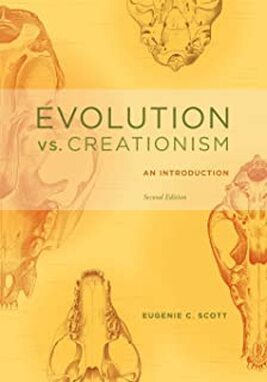 I finally got around to reading this book. It has been on my to-read list for quite some time. Part of the reason I put it off is that I felt I knew the science and the scientific philosophy fairly well (I did) but the book looks at many other aspects of the battle, including: religious perspectives, the media, politics, education and so on. The font is small, the leading tight, and the pages large, so this is a longer read than you might expect.
I finally got around to reading this book. It has been on my to-read list for quite some time. Part of the reason I put it off is that I felt I knew the science and the scientific philosophy fairly well (I did) but the book looks at many other aspects of the battle, including: religious perspectives, the media, politics, education and so on. The font is small, the leading tight, and the pages large, so this is a longer read than you might expect.Part of the reason for its length is that major portions consist of chunks of pro-creationism texts, followed by contrary science positions. Ironically, one of the concerns about creationism is that it survives on the "balance" argument. That is, you are not "balanced" if you do not present "scientific creationism" along side the science of evolution with equal weight in the classroom or the media. And yet, this book goes to some lengths to show the other side. Of course, doing so is necessary in an analysis such as this. However, I often found myself reading something I thought was wrong, only to realize it was the opinion of a creationist, not the author, and is rebutted in the following section.
I read this book to hone my understanding of the arguments, especially the stupid arguments that one can expect from the "other side". I was especially interested in ID (Intelligent Design) arguments.
The last BC skeptic's meeting was a debate between a creationist (Richard Peachy, a part-time science teacher) and an actual science teacher (Scott Goodman). The actual science teacher won. However the audience was absolutely stacked and packed with religion believers hocking tapes, books, and such, about how the Earth is only 6,000 years old. They probably saw the argument in a different light. And they got to flog their propaganda. We were used.
The opening chapters of the book get into the basics of scientific philosophy and provide a primer on evolution. While not mentioned in the book, it is worth noting that the oft used tag line for evolution, "Survival of the Fittest", is a meaningless tautology. Add the word "offspring" and it works.
Consider these four terms and rank them in importance:
Facts, Laws, Theories, and Hypotheses.
In fact, this order is the usual one assigned by lay people, with Facts most important, and Hypotheses least important. Scientists rank them from most to least important like this:
Theories, Laws, Hypotheses and Facts.
The next chapter is a primer on the history of religion and religion's perspectives on evolution. There are actually quite a lot of them, running from "God did it all in a trice" to " The science is true (e.g .: the Earth is 4.5ish billion years old) but god is always invisibly tinkering and setting things in motion". There are at least a half dozen different flavors of creationism and religious evolutionism. Trying to address them all is a cosmic game of Whack-A-Mole. And like the mythical Hydra, if you kill a mole, two slightly different moles pop up in its place.
The US is unique in that it is one country with 50 different policies on science and evolution education. If you are educated in Kentucky, you might not get exposed to evolution at all until you reach college and decide to take an applicable course. And Kentucky is not unique. The BC skeptics once had an ex-cult-member and lawyer address the group. I chatted with him after the fact and was surprised to learn he heard of evolution for the very first time when he was 30!
Chapter five digs into the fight to eliminate evolutionary teaching from science classrooms. Unbelievably, this battle continues to this day.
The Scopes trial is well know from movies and plays. It was the trial of the century at the time. Scopes himself was actually a sacrificial volunteer, chosen because he had few ties to the community, and could thus bear excommunication from it. He was chosen by the ACLU to challenge anti-evolution laws. The Tennessee Supreme Court ultimately reversed the Scopes conviction, which also killed the ACLU's attempts to kill the law (no conviction means no avenue to appeal). The Monkey Trial only made things worse. States doubled down on the issue. New and more subtle attacks on evolution were devised. The language was twisted too. Think about the phrase "scientific creationism", an oxymoron if ever there was one. It was followed by "Intelligent Design (ID)". Most of these approaches failed, so creationists fell back on "equal time". That is, teach creationism along side evolution as an alternative. That failed (it violates the Constitution) and so they fell back on warning labels in text books, wrongly claiming the evolution is only a "theory".
A word on a word: Theory. When Perry Mason as a theory, it means he thinks he might be able to convince a court that his view should prevail. Here, "theory" and "opinion/guess" mean the same thing. In science, a "theory" is a broad perspective that ties together many aspects of data, observation, branches of science, and, usually, mathematics. General Relativity, Newtonian Mechanics, and Evolution are such theories. And they are all true (with some caveats).
Intelligent Design (ID) is the best that creationists have to offer at the moment, and the book goes into detail on it over a few chapters. Intelligent Design, and it hand-maiden Irreducible Complexity, are subtle arguments. In Darwin's day, the argument was: What use is half an eye? Even Darwin knew the answer to that: Any eye is better than none at all. The common example today of ID is the flagellum. This is the twirly thing at that back of some bacteria, making them mobile. But clever scientists have though of step-wise ways of getting to that too.
Intelligent Design was tested in Kitzmiller versus Dover. Dover is a town in Pennsylvania. Dover lost and ID was deemed thinly veiled creationism. Creationism is still fighting and still losing.
When all else fails, creationists fall back on "balance", or "equal time". This is fine in a political argument, but it is the kiss if intellectual death in a scientific one. Scientists, and people in general, must be able to discard discredited ideas, or we will be debating them forever.
The book goes on with chapters on the legal, educational, public opinion, and scientific issues associated with creationism, using a collection of writings from various authors. They present creationist arguments followed by science's rebuttals.
This is a very detailed book. It focuses to a degree on education since the author is the Executive Director of the National Center for Science Education. If you want to understand creationism issues, you should have this book in your library.
Most of the counter arguments to evolution come from the Discovery Institute. It claims that it is scientific in its criticisms, but they do no research, publish no papers, gather no evidence, and spend all their time trying to shoehorn biblical rubbish into the curriculum of US schools.
One last word about Creationism and the Law. Judges are not well equipped to make decisions on issues of science. A group of judges asked Robert Park, a well respected physicist, to tell them the difference between BS science (pseudoscience) and real science. I have just acquired a copy of his book on the subject: Voodoo Science. I shall comment on it soon. Mr. Park wrote an article for Chronicle of Higher Education (2002) that listed seven signs, or "tells", of bogus science and gave it to them. This list was used, and still is, as an aid judges.
I published a list of sixteen such warning signs in the BC Skeptics newsletter in 1989. My list has now worked its way into courseware curricula around the world. My list included all of those expressed in Mr. Parks list. NB: I am not suggesting he stole my list, only that I got there first by 13 years. More on "The List" to come. Regardless, I was chuffed to see that parts of "my list" have made it into US jurisprudence.
The final chapter deals with what people believe around the world. I am happy to report that Scandinavia (Iceland, Denmark, Sweden and Norway) are four of the top seven countries that believe in evolution. Canada was not surveyed. The Turkey beat out the USA for dead last.
As I mentioned, this is a long a detailed read. Some of it is hard to read. I refer mostly to the cut-and-paste discussions from creationists. Their convoluted logic makes my brain hurt. It is also a must-have reference book if you want to take the subject seriously.
Published on August 28, 2020 11:33



